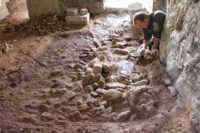 Human remains discovered under the floorboards of a historic beach cottage kitchen in Applecross in the west Highlands of Scotland have been confirmed to date to the Iron Age about 2,000 years ago. The remains, found during renovations on the building in 2015, were initially believed to be around 200 years old, but radiocarbon dating revealed them to be 10 times older.
Human remains discovered under the floorboards of a historic beach cottage kitchen in Applecross in the west Highlands of Scotland have been confirmed to date to the Iron Age about 2,000 years ago. The remains, found during renovations on the building in 2015, were initially believed to be around 200 years old, but radiocarbon dating revealed them to be 10 times older.
The bones were discovered when the floorboards of the kitchen in the Old Estate Office, a listed property built around 1820 on the shoreline of Applecross Bay, were torn up. Under the floor construction crews encountered a skull. The property owners called in archaeologist Cathy Dagg to excavate the find site. The team found more than they expected.
“When we got there and started cleaning it up, we realised there were a lot of skeletal remains there. When we laid them out we realised we had three lower jaw bones, so it was a multiple burial.
“There was a huge number of bone fragments because it was very mashed and really hard to work out what belonged to each skeleton.” […]
Although they were not full skeletons, archaeologists were able to determine that the bones had belonged to a total of six different people.
Applecross is home to the remains of an Iron Age broch/roundhouse that was reused and rebuilt in phases for hundreds of years. Excavations of the broch have found a wide range of artifacts, but no burials. The soil of Applecross and the west coast of the Highlands in general is very acidic, an inimical environment for the survival of bone. The only human remains discovered in six years of digs were a few fragments of burned bones in a cist found in an industrial metalworking area northwest of the broch mound.
Ms Dagg explained that the burial site had been so well preserved because it was on a raised beach with no soil.
“It was very dry,” she added. “We don’t get Iron Age burials surviving because our soils are very acidic over here so they spoil the bone.”
The six skeletons had been further protected by being under the property for hundreds of years, during its time as a merchant’s house, an estate office and a family home
 Today the Estate Office is available for vacation bookings as a self-catering beach house and is a quaint stone cottage with creamy clean interiors. The company paid for the excavation and for the radiocarbon dating, so I wonder if they’ll start leaning into a more gothic pitch now that the renovation has exposed the Iron Age burial ground under the wide-plank hardwoods and stainless steel double fridges of the cottagecore kitchen.
Today the Estate Office is available for vacation bookings as a self-catering beach house and is a quaint stone cottage with creamy clean interiors. The company paid for the excavation and for the radiocarbon dating, so I wonder if they’ll start leaning into a more gothic pitch now that the renovation has exposed the Iron Age burial ground under the wide-plank hardwoods and stainless steel double fridges of the cottagecore kitchen.